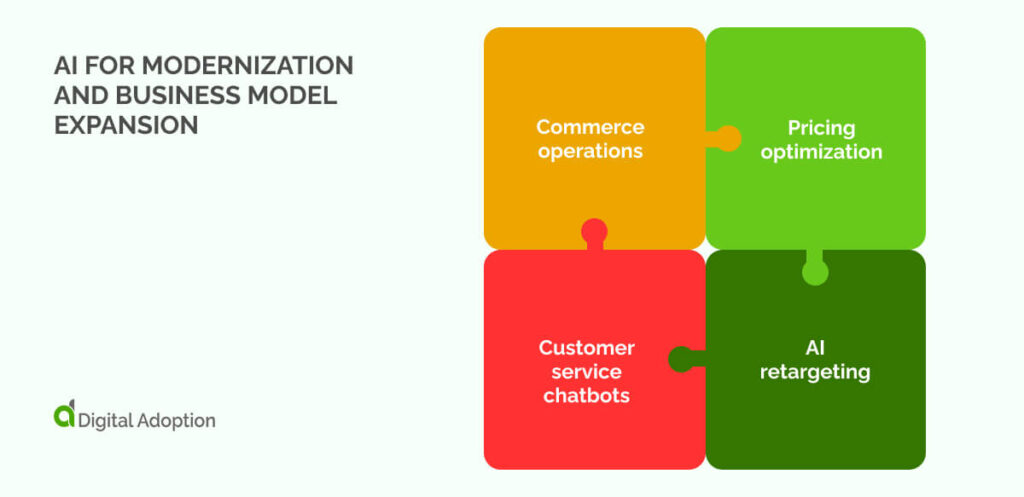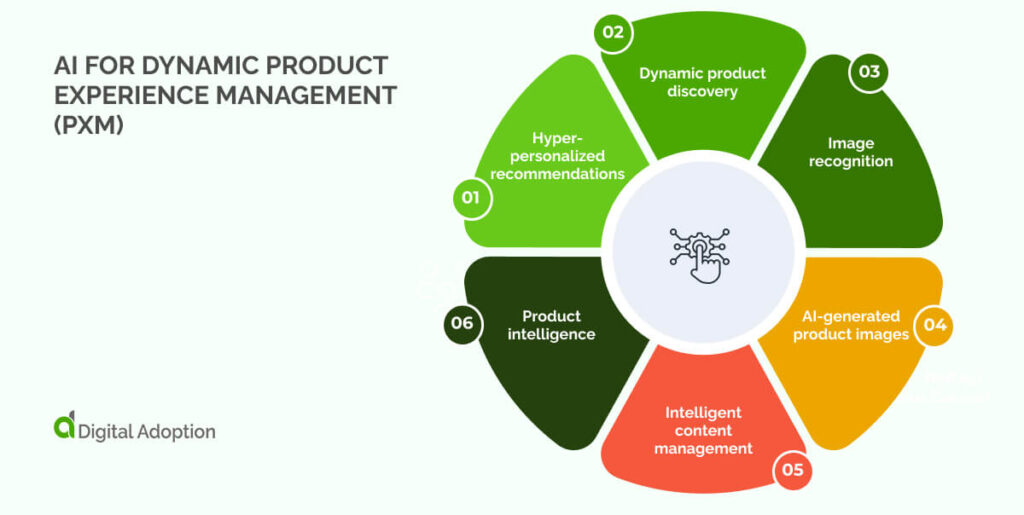AI adoption is changing how eCommerce decisions are made and who makes them.
Merchandising, pricing, and support are shifting from fixed schedules to systems that learn as they go.
Over 70% of retail executives already use AI tools in some form, often to cut the time between insight and action. For example, Amazon’s product suggestions now influence over a third of purchases.
Artificial intelligence models are writing listings, tagging images, and even handling questions once managed by large teams.
AI business models are setting a new rhythm for online retail, where speed, relevance, and scale no longer depend on teams making manual calls but on systems that learn and respond as activity unfolds.
This article examines real-world AI applications in e-commerce that demonstrate how intelligent systems enhance operations, personalize shopping experiences, and secure transactions.
AI in e-commerce examples at a glance:
| AI Technology | Function | Category |
| Commerce operations | Helps manage product listings and orders | AI for modernization and business model expansion |
| Pricing optimization | Changes prices based on sales and stock | AI for modernization and business model expansion |
| Customer service chatbots | Chats with customers and answers questions | AI for modernization and business model expansion |
| AI retargeting | Sends ads to people who didn’t buy | AI for modernization and business model expansion |
| Hyper-personalized recommendations | Suggests items customers might like | AI for dynamic product experience management |
| Dynamic product discovery | Changes search results based on user interests | AI for dynamic product experience management |
| Image recognition | Helps users search with photos instead of words | AI for dynamic product experience management |
| AI-generated product images | Creates product images when missing | AI for dynamic product experience management |
| Intelligent content management | Updates product pages automatically | AI for dynamic product experience management |
| Product intelligence | Spot what items are missing or trending | AI for dynamic product experience management |
| Inventory management | Tracks stock and when to refill | AI for order intelligence |
| Order and supply chain intelligence | Helps plan and track deliveries | AI for order intelligence |
| Intelligent payments | Picks fast and safe payment options | AI for payments and security |
| Risk management and fraud detection | Catches strange or fake purchases | AI for payments and security |
| Compliance and data privacy | Checks if data rules are being followed | AI for payments and security |
| Counterfeit product detection | Finds fake products | AI for payments and security |
| Fake reviews identification | Detects reviews that are fake or paid | AI for payments and security |
AI for modernization and business model expansion

The first housing category is AI for modernization and business model expansion. This category focuses on how retailers update outdated systems and explore new ways to sell.
It includes tools that replace rigid workflows with adaptive, learning-based systems, changing how products are priced, discovered, and delivered.
Commerce operations
AI can watch sales patterns and inventory levels across multiple sources throughout the day. ML models auto-detect low inventory levels across distribution nodes and predict future demand by learning from historical data trends.
These insights send out automatic purchase orders, which help mitigate delays and understocking. The technology also adjusts to sudden changes, like promotions or supply issues, allowing retailers to manage larger volumes without extra staff.
This makes it easier to keep fulfillment and supply chains flexible and responsive as needs shift.
Pricing optimization
Instead of static price lists, machine learning (ML) algorithms adjust costs in real-time based on market demand, inventory, and competitor movements.
This helps pricing become fluid, adapting instantly to changes and enabling retailers to test multiple price points without manual oversight. This system captures revenue opportunities missed by fixed strategies and helps move slow-selling items more efficiently.
Customer service chatbots
Handling customer questions around the clock, AI chatbots for e-commerce respond instantly to common issues, such as order status or returns.
As interactions accumulate, these bots learn to communicate more naturally and accurately. This reduces pressure on human agents, letting them focus on complex problems while customers receive quick, reliable answers at any hour.
AI retargeting
Personalized follow-up ads and product suggestions rely on analyzing browsing behavior and purchase history to provide relevant recommendations.
AI targeting sharpens as systems identify shoppers most likely to make a purchase, minimizing wasted ad spend. Campaigns adapt continuously, refining offers to reflect current user interests and maximizing chances of converting hesitant customers.
AI for dynamic product experience management (PXM)

The next category is AI for dynamic product experience management (PXM). This area focuses on how AI customizes product information and presentation to match individual shopper preferences and contexts.
It moves beyond static descriptions, generating tailored content, images, and recommendations that evolve based on browsing behavior, location, and device.
Hyper-personalized recommendations
Shoppers can now receive product suggestions based on their past behavior, such as what they’ve clicked on, viewed, or bought. These recommendations update as the shopper interacts with the site, making the experience feel more personal.
Instead of seeing generic lists, customers receive options that cater to their unique preferences. This means shoppers can find products more quickly and are encouraged to make additional purchases, resulting in a smoother and more engaging shopping experience that requires no human intervention.
Dynamic product discovery
Product listings and categories change based on the shopper’s interests and current popularity. Instead of a fixed menu or static filters, the system highlights items that match recent browsing habits, trending styles, or inventory levels.
This makes it easier for shoppers to discover new and relevant products they might not have found otherwise. Retailers can quickly update product selection using product enablement tools, responding to changes in demand or seasonal shifts without manual labor.
Image recognition
Image recognition technology “looks” at photos and videos to figure out what products they show. It automatically tags items, links similar products, and updates catalogs. Customers can even upload their pictures to find matching or related products.
This makes searching by image simple and accurate. At the same time, it maintains consistent product data across websites and apps, enabling customers to find exactly what they want without confusion or errors.
AI-generated product images
Rather than relying solely on photos taken by people, AI can generate product images from descriptions or existing pictures. This helps brands showcase different colors, angles, or styles without the need for expensive photo shoots.
AI-generated images fill gaps in product catalogs and also speed up content creation. They allow retailers to test which images attract the most attention. This keeps product visuals fresh and varied while cutting costs and reducing time spent on producing new photos.
Intelligent content management
AI organizes and updates product information across all selling channels automatically. It adjusts descriptions, specifications, and offers depending on where the customer shops or their profile.
This ensures that product details remain accurate and relevant across websites, mobile apps, and marketplaces. The system reduces errors and saves teams from having to edit content manually. Shoppers receive the right information, regardless of how or where they browse, making it easier to decide what to buy.
Product intelligence
AI tracks how well products sell, what customers think, and how the market changes over time. It identifies which products are doing well and which ones are not. Retailers use this data to make smarter choices about stocking, pricing, and promoting items.
Businesses get clear insights on what drives sales or causes issues. This helps improve inventory management and marketing strategies, keeping the company more responsive and enabling customer success.
AI for order intelligence
The next category is AI for order intelligence. This category examines how machine-led insight is changing how orders are anticipated, managed, and fulfilled.
It shifts the focus from static, rule-based systems to adaptive models that respond to real-world signals, including what people buy, when they make a purchase, and how often they return items.
Inventory management
Stock levels no longer hinge on outdated forecasts or broad seasonal assumptions. AI now reads patterns across sales, regional trends, and fulfillment data to fine-tune inventory decisions.
It identifies which products are moving, which are stalling, and where gaps may appear next. That means fewer stockouts, less overordering, and tighter control, all without the need for traditional spreadsheets. For retailers, it’s a shift from reacting to anticipating, and maintaining lean inventory without risking lost sales or excess waste.
Order and supply chain intelligence
Orders don’t just tell you what is sold; modern systems tell you where the system bends. AI listens to those signals and identifies delays, mismatches, and friction across suppliers, warehouses, and carriers.
Retailers are now receiving early warnings and concrete suggestions, meaning the supply chain becomes less of a guesswork and more of a feedback loop. It’s faster fulfillment and a smarter system that learns and adjusts with every transaction.
AI for payments and security
The last category is AI for payments and security. This category is particularly important because it deals with trust at the point of transaction, where decisions are final, and risks are highest.
AI monitors behavior in real time to spot fraud, flag suspicious activity, and reduce false declines without slowing down the checkout process.
Intelligent payments
Payment systems now adjust concurrently to how people make purchases online. They prioritize speed for repeat buyers, add friction when something seems off, and tailor payment options based on user history and context.
That means fewer drop-offs at checkout and higher approval rates without manual tuning. Behind the scenes, systems strike a balance between convenience and caution by tracking behavior patterns across channels, not just whether a card works, but whether the transaction aligns with the broader context.
Risk management and fraud detection
Every transaction carries context, timing, location, device, and order size. Fraud hides in patterns that often go unnoticed. AI risk management systems compare incoming orders against billions of previous ones, flagging anomalies within milliseconds.
The system learns from past fraud cases but also adapts when tactics change. It protects both the buyer and seller without requiring blanket rules that block legitimate customers. Real-time detection limits exposure without slowing down high-value, legitimate transactions.
Compliance and data privacy
Retailers often handle large amounts of personal and payment data. Systems can now track how that data is stored, accessed, and shared, alerting teams when something falls outside the policy.
Whether it’s geographic restrictions or consent requirements, the system enforces data privacy rules quietly but thoroughly. This means data stays where it should, with access limited by context. It’s a shift from checklist AI compliance to constant oversight, with alerts and controls designed to catch issues before they spread.
Counterfeit product detection
Copycat products often mimic visuals, pricing, and even metadata in some cases. Detection systems now monitor seller behavior, product uploads, and review patterns to surface suspicious listings.
They cross-check new items against trusted catalogs, flagging subtle differences and pricing anomalies. Retailers can take action before bad listings damage trust or performance. This type of early warning helps platforms maintain a clean catalog, protect their brand image, and reduce customer complaints associated with counterfeit goods. It also preserves customer loyalty by ensuring buyers get what they expect.
Fake reviews identification
Fake reviews often follow patterns, including similar wording, clustered timing, or accounts with no other activity. Detection tools scan for these signals, analyzing tone, language, and posting behavior.
When suspicious patterns appear, the system flags them early. Removing this noise helps surface genuine feedback, making it easier for buyers to trust what they’re reading. That protects the shopping experience and preserves fairness across product rankings.
Ensuring the future of AI in eCommerce
You’ve seen the many ways AI is expected to, or already has, reshape the e-commerce sector, which continues to grow year on year, quickly outpacing brick-and-mortar stores.
With the rise of online shopping, the industry is moving toward large-scale adoption of AI to streamline operations, enhance security, and deliver a more comprehensive customer experience through automation and intelligent systems.
Now is the time for e-commerce businesses to invest time, effort, and resources in AI strategies designed for a future that is moving faster than ever before.
eCommerce businesses that hesitate risk being left behind by a market that isn’t showing any signs of slowing down.
People Also Ask
-
How to use AI in eCommerce with low riskStart small. Set a clear goal and test things before using AI everywhere. Watch how it works and fix problems early. Involving different teams ensures that issues don’t get missed. Use clean, reliable data. Don’t trust new tools too quickly—wait until they prove their effectiveness.
-
Limits of AI in eCommerceAI needs strong data. If the data is messy or incorrect, AI will produce inaccurate results. It also doesn’t fully understand people’s thoughts or feelings. It can make mistakes if you let it run too much on its own. Old systems may also make it hard to use.
-
Traditional AI vs. Generative AITraditional AI identifies patterns to help categorize products or detect fraud. Generative AI creates things. It can write descriptions or make product photos using short instructions. One sorts data. The other builds content.

 FACT CHECKED
FACT CHECKED![17 Examples of AI in eCommerce [2025]](https://www.digital-adoption.com/wp-content/uploads/2025/07/17-Examples-of-AI-in-eCommerce-2025img.jpg)







